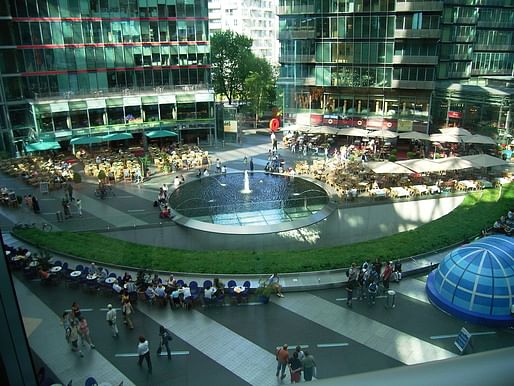
-The following is the 2nd portion of my Interview with Peter Walker.-
Peter Walker’s Minimalist style
In the 1950s and 1960s “two major schools existed at the time - Minimalism, an offshoot of conceptualism, and then Pop” (i.e. Andy Warhol). Walker was interested in Carl Andre and Donald Judd. “Judd and Andre were doing things out of doors with several pieces out in the landscape.” These objects went “beyond objects seen in space and gestured to big space,” says Walker. Often, the focus was not simply about the object in and of itself. The object was calling attention to something else. In Carl Andre’s piece “Zinc-Lead Plane” sought to call attention not to the square pattern on the flat plane but to control the space which was above the plane.

Like Kiley and many others, Walker began to collect a vocabulary about himself which could inform and shape a new design language within the landscape. Walker “read everything about modernism and minimalism and what they (Judd) wrote. He was a very thoughtful and educated guy,” says Walker. Walker also began to collect art in the early 1970s and has acquired an extensive collection.
The learning process seemed to be very experiential for Walker. A few years ago Walker was attending a history lecture at IIT. “At the time I was familiar with Mies van der Rohe. I spent three hours walking around campus and finally grasped what the architecture and landscape relationships were. More examples came to Walker through learning about how the “International style relates to minimalism, and how things are put together with scale, proportion.” These often, “came not through Frank Lloyd Wright but Corbusier and Mies.”

Walker continued “trying to find what they were doing and copying to learn.” Gradually he “developed a set of principles on how to make these forms and formal attitudes and some of the rules (like Mies and Judd did) and how they could relate to landscape.” Referring to Dan Kiley, “he used classicism. I use minimalist art,” Walker states. “Le Notre is my hero.” Similarly, Kiley and Walker sought to achieve what minimalist artists do not. “Minimalists try to produce something you look at. Kiley and I are trying to build something you can get into and use.”
“There are couple of ways to get at minimalism. 1. Simple concept. Take a square or sphere and just build it. Then turn it around and change or modify it. 2. Start with something more complex and complicated and reduce and get rid of what is not needed. I use both. I sometimes start on the inside and generate out or start on the outside and reduce inward.” Walker uses the analogy of marble sculptures from Greco-Roman times and their ability to release what was inside to further illustrate his point.

These concepts are found in works like that of Le Notre at Parc du Chateau de Chantilly. “Great Baroque gardens are huge and simple. Chantilly by Le Notre has nothing in it. It is reductive.” Walker attempts to bring this level of simplicity to his works. “Everything has to have three, four, or five uses. This is a method of reducing. Complexity and simplicity at the same time produce tension.” Referring to some of his own designs Walker states that “sometimes they are technologically expensive.”

I asked Peter if his design for the Sony Center in Berlin, Germany was one such example of the complexity and simplicity. Specifically I inquired about the cantilevered water feature which overhangs a Cineplex lobby below. “Yes. It was used in a modernistic and minimalist way. Instead of flying water in the air, it was used in a reflective way. It can sit there and do its work without a lot of electricity. It was used for its transparency and as a reflective pool. It does two jobs at once.” This ability to achieve multiple things with little effort and little expense is a quality which Walker finds admirable. “Olmsted was not very expensive. Neither was Le Notre. Laurie Olin lectured on Le Notre’s tricks to cheapen things. Le Notre often used very simple devises.” http://tclf.org/pioneer/oral-history/laurie-olin
Concluding thoughts
There are a few important points which we can glean from Mr. Walker’s responses and experience.
1. Modernism and Minimalism in the field of landscape architecture are styles which are not fully realized or understood. One reason for this is our proximity in time to these designs.
2. A design vocabulary is still being developed which helps us put words to and gain understanding of modernism and minimalism. (This is true in the field of landscape architecture and our sociological systems worldwide.)
3. There seems to be a lack of dialogue about these styles within the profession. While other professions are considering the topic, it would be beneficial for landscape architects and design academics to boost their involvement in the conversation.
I would like to express my appreciation to Mr. Walker for his generosity with his time and his willingness to participate in my interview. Also thanks to Janet Beagle at PWPLA for working so diligently to arrange this opportunity.
Should you have more interest in learning about Modern landscape architecture visit the below links.
http://www.amazon.com/Modern-Landscape-Architecture-Critical-Review/dp/0262700514
Visit PWPLA here: http://www.pwpla.com/
To read the first part of this two part interview go here.
View the Miller House by Mid-Century Landscape Architect Dan Kiley HERE.
A Brief article about the 9/11 Memorial in NYC by PWPLA. Read Here.
I currently maintain a blog which features monthly firm interviews about their firm and specific projects in the Knoxville or near Knoxville area. Readers can also find information on photography, current trends in representation, or even social equality issues.



No Comments
Block this user
Are you sure you want to block this user and hide all related comments throughout the site?
Archinect
This is your first comment on Archinect. Your comment will be visible once approved.